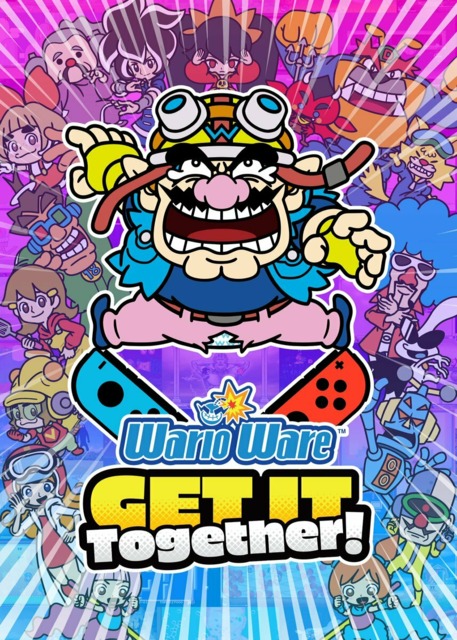WarioWare: Get It Together! (Switch) Review
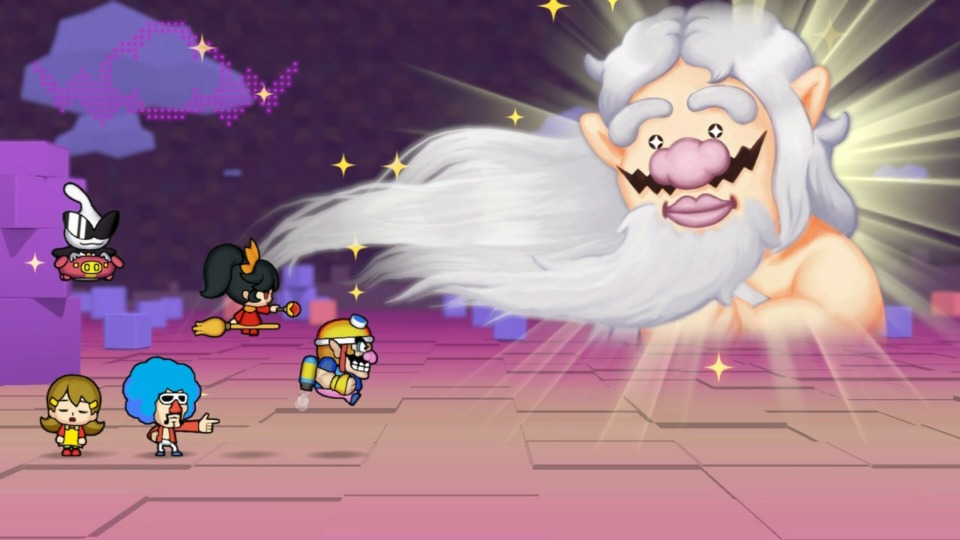
Note: I played this game solo and without Nintendo Switch Online, so this review is most suited for those with similar parameters. Also, this review will not be in-comparison to previous WarioWare games.
Wario may live under the shadow of his arch-rival Mario, but that doesn’t stop him from showing up from time-to-time with an occasional WarioWare release. Much like the many other franchises under Nintendo’s belt, this garlic-loving anti-hero brought his long-running series to the Switch with WarioWare: Get It Together! While this game may not be for everyone, Wario’s large collection of micro-games offers bite-sized, fast-paced fun that can last for as long or as short as you would like them to.
Get It Together! stars Wario and his large group of friends after developing a new game to sell. Rather than working normally, however, the console sucks Wario and company into the game. Upon entering, he discovers that this world is full of bugs, so he goes out on a quest to complete the levels in the hopes of squashing bugs and reuniting with his friends.
Before I get any further with the review, I think it is worth explaining what this game is. WarioWare is a large collection of micro-games, which are small interactions with even smaller time frames to complete them in. Each level in the game consists of completing a certain amount of micro-games followed by a boss micro-game (which tends to have a bit more going for it compared to normal ones), and its pace gets faster and faster as the level progresses. Replaying a level will have the micro-games loop infinitely, and the goal is to get the highest score possible.
So, what do these “interactions” entail? It could be solving a simple puzzle, navigating a small platforming segment, memorizing a simple sequence of events, dodging something, collecting something, hitting something enough times to make it do something, and more. The controls for every micro-game consists of the thumbstick for movement and a single button for interaction or jumping, which I greatly appreciate as it’s easy to pick up for both solo and co-op play and it allows for a smooth flow from one game to the next. While these interactions and the controls may sound simple—and they are—the difficulty of these micro-games is in only being given a very small amount of time to figure out what to do and how to do it. Completing a micro-game adds one to the score, losing it costs one-of-four lives, and hitting zero lives is game over.
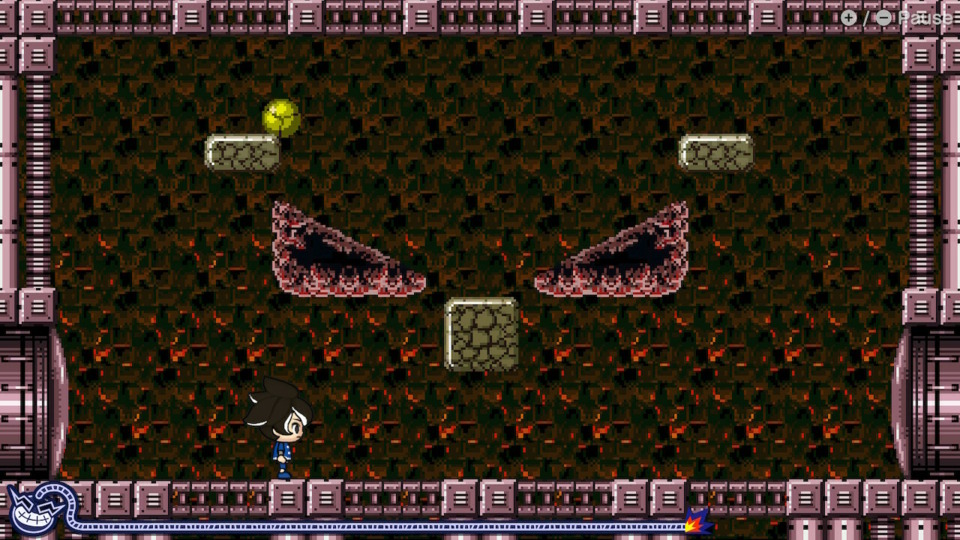
Get It Together! includes over 200 micro-games, and while it can be pretty easy to lump them under a few categories and compare them to each other, I think what is offered has a good amount of variety to it. Not only that, but each micro-game has a few variations to it so that the puzzle stays unpredictable. For example, there is one micro-game where you must choose between entering one-of-two rockets, with only one being the right answer. Each time you play the level, the wrong ship will be wrong in different ways, such as it being filled with food or it being underneath a roof. On top of its variations, the various themes, art styles, and methods of achieving each micro-game differentiates even the similar ones just enough to keep them from feeling repetitive. Speaking of art, the wide range of art styles and pictures ranging from crudely drawn images to beautiful-looking paintings and everything in between is a joy to look at because of its creativity, and weirdness. Seeing Wario’s identifying features infect just about everything or seeing some of the weird victory screens plays into the micro-games well and gives WarioWare a personality just as bizarre as Wario himself.
As for the quality of the micro-games, they can vary from whatever to creative and a lot of fun. The beauty of this game is that it won't give you enough time to dwell on the not-so-great micro-games, so I only really found myself thinking about the ones that made a good impression on me rather than the sour ones. As for the good micro-games, there are some pretty cool ones like a golf game where you push the terrain around to get the ball in the hole and a puzzle game where you use a mirror to navigate to a door. There are also a handful of micro-games based on other Nintendo games, which even includes a recreation of Super Mario World levels. While these micro-games aren’t large enough to be standalone games, they are still enjoyable to play and work well as a pack.
The big new feature this game touts is its roster of characters to play. This game features twenty characters to unlock, and each one has their own style of movement and ability. Wario floats around and can ram into things, 18-Volt shoots projectiles and can only move by shooting at rings situated around the level, Jimmy dashes in whatever direction you aim, and so on. Having that variety not only helps with appealing to different play styles, but it also adds more variety to each micro-game, as the method and strategy needed to complete the task at-hand can vary drastically between characters.
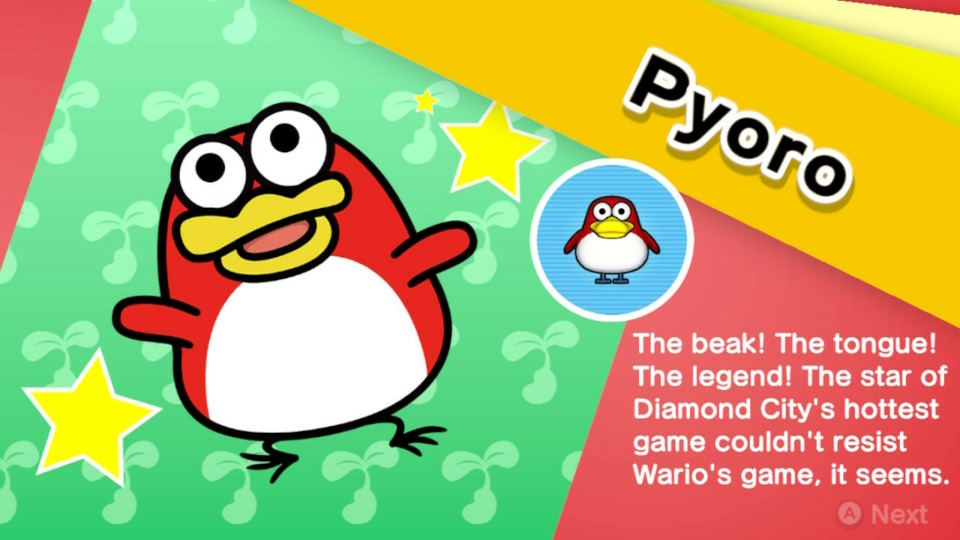
While I think the various character abilities are neat and there are some cool characters to play around with, I also found some issues with Wario’s band of friends. For starters, while some characters are better suited than others for each micro-game (something even the game acknowledges), some characters like 9-Volt are just bad all-around and I think the weaker ones shouldn’t be here because of their uselessness. Some of the characters are too similar to each other to justify their existence, such as Master Mantis and Cricket whose only difference is that Mantis can stick to ceilings. Also, there are two characters (or rather four) that are co-op centric characters, such as Dribble and Spitz who have the same abilities except for the fact that they shoot a projectile in opposite directions. The game doesn’t allow solo players to play as the player-two character in some of the modes, and while Spitz is just a flipped version of Dribble, I still wish I had the ability to play as him or Ana.
Where these new characters ultimately falter is when this game starts to pick up speed, as trying to comprehend both the level and the character can be tough when the game’s going at a breakneck pace. There is a short second of respite between each micro-game where you get to see and play around with the character you are about to use, and while I think it is helpful in preparing for what’s ahead, it still can be a bit much considering how fast this game can get. In the end, I found that their movement such as whether the character can fly around, platform, dash around, and so on is vastly more important than their abilities, and a fair amount of micro-games can be solved by pushing things around with movement rather than using abilities. It didn’t take long for me to discover that the characters who can fly around are the most versatile, and while I appreciate some of the variety and challenge of using the other characters, I found myself focusing on the characters I like for the sake of a high score rather than playing around with all characters for the sake of variety, resulting in a large portion of the roster collecting dust. I think the characters are a neat idea, but I would also like to see an alternative of this game that doesn’t have different characters so I can see what freedoms would be allowed without the restrictions of making sure every micro-game works with every movement style and character ability.
The main part of this game is the story mode, which involves completing levels that consist of a set amount of micro-games followed by a boss stage. Each new level has a different theme to it, and a new character that ties to that theme is unlocked. The game also forces you to play with each new character in the story mode, but that lock is lifted when replaying the level. After completing each level, you earn some money and continue on to the next level.
Playing through the story mode for the first time isn’t as fun or notable as replaying the levels for high score; but like the micro-games themselves, the story mode doesn’t last too long, so any frustrations I could have with being forced to play a certain character or not having certain features unlocked until the end of the campaign didn’t really stick with me. Speaking of which, there is actually a fair bit of this game that is locked until completing the story mode including the true purpose for earning money, but the story mode only took me a few hours to complete so I didn’t get too caught up on it. There is, however, a use for money during the story mode, and that is to continue where you left off if you lose all your lives, which I appreciated as it allowed me to not get too caught up on any level I struggled on while playing through everything for the first time. Playing through the levels the first time around doesn’t entirely reflect what this game is about, but it’s still enjoyable to play through and it doesn’t take a long time to unlock everything this game has to offer.
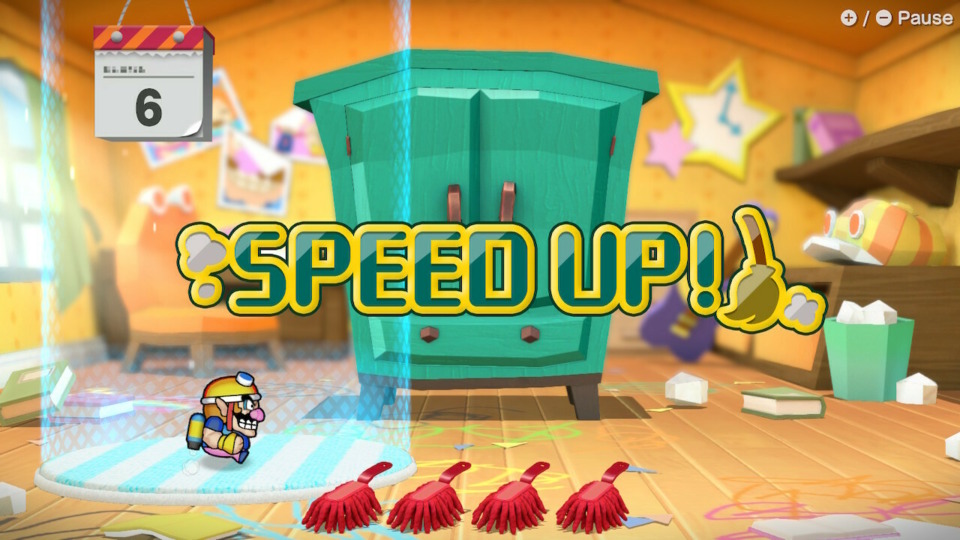
Once the story mode is complete, the rest of the game opens up, though a large part of this game is going back and replaying levels. When replaying a level, there are a few differences. Levels go on infinitely, and the goal is to get a high score rather than fight a boss and complete the level. There are still four lives, but successfully completing a boss stage will give one life back. Also, failing a boss stage will move on from it rather than staying until it’s complete. After each boss stage, there is a short bonus level that’s all about picking up as much money as possible. Speaking of which, the amount of money earned is based on how far you get rather than a fixed amount, and you can no longer spend money to continue after failure. One thing I found funny with the post-game story mode is the ability to play the credits as a level, in which the characters try to push the credits out of the screen. The only thing I wish was added to the story mode after completion is the ability to play each level as one character, but the game only allows either your choice of 3-5 characters or all characters. Replaying these levels for high score is where the bulk of the game is at, and while I enjoyed trying to see how far I can get, I can also see people burning out at this stage and considering their time with this game complete.
So with all of this talk of money, what do you do with it? Money is spent on purchasing prezzies, which are items that you can get by either purchasing them directly from a shop that refreshes every few hours or through a gacha machine. There are 100 prezzies in total, ranging both in quality and favorability to each character, and each character has one-of-five levels of favorability for each item. Prezzies can be given to the characters in the break room, which is where you can also customize their look, replay their tutorial levels, and check out some gallery art. Leveling up characters will boost their Wario Cup base score (which I will touch on in a bit) as well as unlock new skins, gallery art, and title cards, and while everything is unlocked at level thirty, characters can keep leveling up to increase their base score. I think adding this form of grinding to the game is neat as it doesn’t interfere with the main game, and I enjoyed trying to get all the prezzies and figure out which ones are best suited to each character.
Also in the realm of collection are the missions and the Play-o-Pedia. Missions are essentially achievements ranging from completion to high scores and even specific tasks, and they all reward money. There are a ton of missions to complete, and while some like a few basic co-op missions and Wario Cup missions that aren’t possible to get as of writing this are a bit troubling for me, I think they offer a ton of challenge and replay value. The Play-o-Pedia is a compendium of all the micro-games in WarioWare, and you can play each one individually from here. Not only do you get a selection of either playing with 1, 3, 5, or all characters, but it will also show which characters are most compatible for each micro-game with a smiley-face rating scale, and getting to a certain score using the all character option will net some money. Even without some of these features, I think being able to play and practice every micro-game with each character helps a lot as well as offers a lot of high scores to achieve (if you want to get a high score using every possible micro-game/character combo), and missions offer a lot to go back to if trying to get high scores for the sake of getting high scores isn’t your forte.
Outside of the micro-games, there are a few mini-games in the form of the variety pack section. Most of these mini-games require two or more players, but there are a few solo ones I could play. My absolute favorite mini-game in this pack is Friendless Battle, which is about choosing a character and fighting in an arena against the other characters for as long as possible. Using character abilities to defeat opponents rather than complete tasks was a lot more fun for me, and I even found myself enjoying the characters I normally hated. Another mini-game is Gotta Bounce, which is a slight upgrade to one of the micro-games about keeping a ball from touching the ground. Daily Grind is a mediocre platformer about picking up contracts and avoiding enemies, but it’s way too easy and boring to be enjoyable in solo. Finally, High Five is essentially volleyball with a few small twists to it, and while I can see this being a blast for a group of friends to really get into, I didn’t find it all that appealing for solo play. Outside of Friendless Battle, the variety pack is primarily meant for co-op play, which I can appreciate but also didn’t find as fun considering the fact that I’m playing solo.
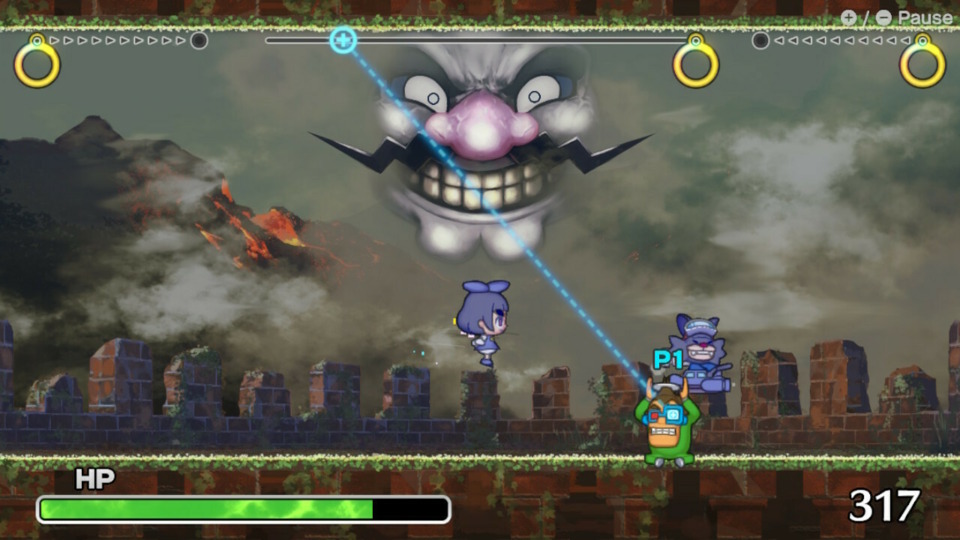
The final mode in this game is Wario Cup, which is a weekly challenge mode. As of writing this, there’s only the first week’s challenge, so this part may be subject to change a bit, but this mode offers a level to complete each week in which the micro-games are hand-picked and there are modifiers added. There are two types of levels planned: score attack and time attack. The Wario Cup level I played was a score attack level where 9-Volt went through 34 micro-games in a specific order at a super fast speed. The intention of this mode is to compete for the top spot on an online leaderboard, but this game also offers a bronze, silver, and gold medal (along with some money) for achieving certain score thresholds, which means I as a non-Switch Online subscriber can still enjoy this mode. It’s an enjoyable mode and I’m interested in seeing what they do with it, but there is one issue with the scoring that could be an issue for online leaderboards.
Earlier, I mentioned the Wario Cup base score for each character, and this is where it applies. Since (at least for the one Wario Cup level I played) there is a highest score possible (completing all 34 micro-games), there is the issue of a bunch of people clumping up at the top of the leaderboard with the highest possible score. To alleviate this issue, WarioWare uses the base score as a multiplier onto the score, which means a higher-leveled character will get more points for completing a micro-game than a lower-leveled character. I get wanting to break up the leaderboard scores, but doing so by rewarding those who did more character level grinding doesn’t seem like the right choice. It ultimately doesn’t affect me as a solo player, but I could see this being an issue for those who take this mode seriously.
In the end, WarioWare: Get It Together! is an enjoyable micro-game experience that isn’t really like any other mainstream game on the market. How much people are going to get out of this game, though, is the big question, as playing through everything once will last 4-5 hours whereas diving in for high scores or completion will last much longer. Despite having some issues with the characters and some repetitive game design, I think this game is definitely worth checking out for Switch owners because of how unique and fun this experience is.
